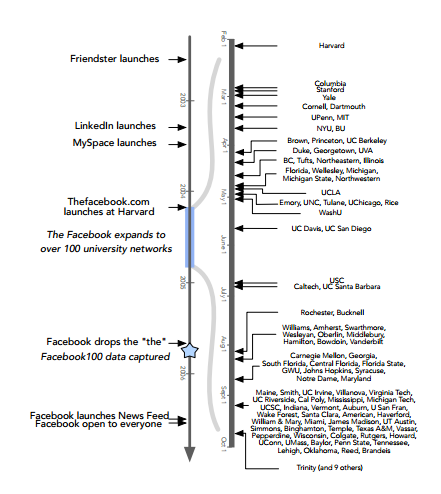Network Archaeologists Discover Two Types of Social Network Growth in Historical Facebook Data
On February 4, 2004, an entirely new website opened its doors aimed at students at Harvard University. Thefacebook.com was an online social network designed to compete with the growing numbers of others that had recently emerged, such as Friendster.com, MySpace.com, LinkedIn.com and so on.

Facebook’s popularity grew quickly but was initially limited to university networks. Within a month, it had launched at Columbia, Stanford, Yale, Cornell, and Dartmouth universities. And it soon spread to others, expanding to cover 100 university networks in the first year before opening to the general public in mid-2006.
The rest is history. Facebook’s growth since then has been explosive and now covers a significant fraction of the planet. Today, Facebook boasts some 1.4 billion active monthly users all over the world.
That raises an interesting question. How does this early growth occur? And how does it differ from the type of growth that occurred later in the social network’s life?
Today, we get an answer to many of these questions thanks to the work of Abigail Jacobs at the University of Colorado Boulder and a few pals who are computer scientists turned network archaeologists. These guys have analyzed the Facebook 100 network data for the first time and compared it to the more mature network.
The approach is relatively straightforward. This structure of the Facebook networks at these first 100 universities forms a unique database. It shows exactly how an online social network grows in its first few months of life. And by comparing the growth of this early network with its later growth, it ought to be possible to tease apart the different factors at work.
These guys simply compare the structure and growth rates of networks in each of the first 100 universities to adopt Facebook. They then ask how the observed changes are related to the size of the network and its age.
The results make for interesting reading. Jacobs and co say that in general, these networks all have the classic small world structure found in almost all social networks. This is characterized by large numbers of short links within the network and a small number of distant links that have the effect of knitting the network together.
But the network growth shows a clear two-phase pattern. Initially, these networks grow by the addition of new members who form nodes in the network with a relatively small number of connections between them. “For early Facebook, each time a new college joined, or a new class arrived on campus, this phase started anew within that population and proceeded as the adoption rate rose from zero,” say Jacobs and co.
But there is another phase where the mechanism of growth is different. This begins once a network has expanded to include a large fraction of the available population. Then, the main form of growth involves people increasing their numbers of contacts among existing users. This has the effect of increasing the density of the network.
These two phases correspond to growth that occurs before and after saturation, when most of the available population has already signed up.
Jacobs and co say they find several different examples of this two-phase pattern of growth. The first occurs within university networks themselves. The saturation point had occurred in almost all these networks by 2006, just before Facebook opened up to the general public.
Then, as the social network spread into the much larger, unadopted population, it moved back into a phase of natural growth by adding extra nodes. However, saturation occurred once again in 2008 when the network has recruited a large fraction of the planets connected population.
“As Facebook spread into this large and unadopted population, its diameter expanded and its degree distribution became more heavy-tailed, before transitioning back into the densification phase, as a greatly enlarged system, in 2008,” says Jacobs and co.
The team says the discovery of this kind of two-phase growth has some interesting implications. In particular, Jacobs and co suggest that online social networks could be designed to take advantage of the type of growth that they are currently undergoing.
So a network undergoing natural growth might have a different set of features than one that had achieved saturation and was growing by densification. “Human behavior is not independent of the design of these systems, and designs are likely to be more effective and more useful if they are informed by an understanding of their impact on the long-term structure and function of these networks,” they say.
This network archaeology provides an interesting insight into the nature of social networks and how they grow. Just how this should be best exploited in the next generation of networks is not yet clear. But more detailed study of this phenomena should throw up some interesting clues.
Ref: http://arxiv.org/abs/1503.06772 : Assembling thefacebook: Using Heterogeneity to Understand Online Social Network Assembly
Keep Reading
Most Popular
Large language models can do jaw-dropping things. But nobody knows exactly why.
And that's a problem. Figuring it out is one of the biggest scientific puzzles of our time and a crucial step towards controlling more powerful future models.
How scientists traced a mysterious covid case back to six toilets
When wastewater surveillance turns into a hunt for a single infected individual, the ethics get tricky.
The problem with plug-in hybrids? Their drivers.
Plug-in hybrids are often sold as a transition to EVs, but new data from Europe shows we’re still underestimating the emissions they produce.
Stay connected
Get the latest updates from
MIT Technology Review
Discover special offers, top stories, upcoming events, and more.